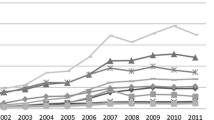Abstract
This article focuses on the impact of agglomeration and labour market factors on the location choice of MNEs in post-transition economies. We compare data from 33 regions in East Germany, the Czech Republic and Poland using a mixed logit model on a sample of 4,343 subsidiaries for the time period between 2000 and 2010. The results show that agglomeration advantages, such as sectoral specialization as well as a region’s economic and technological performance prove to be some of the most important pull factors for FDI in post-transition regions. With respect to access to labour, the results suggest that FDI in post-transition regions is (no longer) only dominated by efficiency seeking behaviour, but also by access to well-qualified labour.

Similar content being viewed by others
Notes
The derivation of the price index P can be found in e.g. Wied-Nebbeling and Schott (2001, 320pp.).
This implies that the delivery of x goods from the location of production j to market m requires the shipment of ϕ jm x goods. By definition, ϕ jm exceeds unity if m does not correspond to j. If the goods do not cross region j, ϕ jm equals one.
See Appendix 1 for a detailed specification of the coefficient vector β.
For reasons of simplicity, the sectoral subscript k of the theoretical model is omitted in the following notation.
In this framework, each case represents the location decision for one subsidiary. This assumption does not exclude the possibility that a firm can choose several locations for its subsidiaries since different subsidiaries can have the same investor.
For reasons of simplicity the individual-specific regressors will be omitted in the following notation.
By definition, the conditional logit framework includes only alternative-specific attributes (see e.g. Greene 2003). In order to include individual-specific variables in the regression, the individual-specific attributes will be interacted with country dummies.
In this case, we compare the estimates of unrestricted model with 3 different subsamples, in which each country is excluded once.
The results of the conditional logit regression and of the corresponding Hausman tests are available upon request.
See Train (2009, p. 138) for further details. for further details.
See Basile et al. (2008, p. 331).
See Günther et al. (2011, p. 535) for more detailed information.
See Mukim and Nunnenkamp (2012, p. 897) among others.
See Frietsch et al. (2011).
The Polish sectoral wage rates could not be calculated for the year 1999 since the Polish sectoral employment figures have only been available since 2000. Hence, for the Polish investment decisions in 2000, we use an all-sectoral wage rate in order to extend sample size.
A high diversification does not necessarily exclude potential inter-industry linkages.
See Paqué (2010, 9pp.).
References
Amiti M, Javorcik B (2008) Trade costs and location of foreign firms in China. J Dev Econ 85(1–2):129–149
Andrews M, Bellmann L, Schank T, Upward R (2007) The takeover and selection effects of foreign ownership in germany: an analysis using linked worker-firm data. GEP reserach paper 08
Barrios S, Görg H, Strobl E (2006) Multinationals’ location choice, agglomeration economies, and public incentives. Int Reg Sci Rev 29(1):81–107
Bartik T (1985) Business location decisions in the United States: estimates of the effects of unionization, taxes, and other characteristics of states. J Bus Econ Stat 3(1):14–22
Basile R, Castellani D, Zanfei A (2008) Location choices of multinational firms in Europe: the role of EU cohesion policy. J Int Econ 74(2):328–340
Bevan A, Estrin S, Meyer K (2004) Institution building and the integration of eastern europe in international production. Int Bus Rev 13(1):43–64
Boudier-Bensebaa F (2005) Agglomeration economies and location choice: foreign direct investment in Hungary. Econ Transit 13(4):605–628
Brülhart M, Jametti M, Schmidheiny K (2012) Do agglomeration economies reduce the sensitivity of firm location to tax differentials? Econ J 122(563):1069–1093
Chidlow A, Salciuviene L, Young S (2009) Regional determinants of inward FDI distribution in Poland. Int Bus Rev 18(2):119–133
Cieslik A (2005) Regional characteristics and the location of foreign firms within poland. Appl Econ 37:863–874
Crozet M, Mayer T, Mucchielli J (2004) How do firms agglomerate? A study of FDI in France. Reg Scie Urban Econ 34(1):27–54
Detscher S (2006) Direktinvestitionen in Mittel- und Osteuropa. Determinanten und Konsequenzen für den Transformationsprozess. VDM Verlag Dr. Müller
Disdier A, Mayer T (2004) How different is Eastern Europe? Structure and determinants of location choices by French firms in Eastern and Western Europe. J Comp Econ 32(2):280–296
Dixit A, Stiglitz J (1977) Monopolistic competition and optimum product diversity. Am Econ Rev 67(3):297–308
Dunning J, Lundan S (2008) Multinational enterprises and the global economy. Edward Elgar Publishing, Cheltenham, UK
EBRD (2009) Transition Report 2009: Transition in Crisis? European Bank for Reconstruction and Development, London
Frietsch R, Schmoch U, Neuhäusler P, Rothengatter O (2011) Patent applications-structures, trends and recent developments. Fraunhofer-Institut für System-und Innovationsforschung—Studien zum deutschen Innovationssystem
Galego A, Vieira C, Vieira I (2004) The CEEC as FDI attractors: a menace to the EU periphery. Emerg Mark Finance Trade 40(5):74–91
Gauselmann A, Knell M, Stephan J (2011) What drives FDI in Central-Eastern Europe? Evidence from the IWH-FDI microdatabase. Post Commun Econ 23(3):343–358
Girma S, Görg H (2007) Evaluating the foreign ownership wage premium using a difference-in-difference matching approach. J Int Econ 1:97–112
Greene W (2003) Econometric analysis, vol 5. Prentice Hall, Upper Saddle River
Guimarães P, Figueiredo O, Woodward D (2000) Agglomeration and the location of foreign direct investment in Portugal. J Urban Econ 47(1):115–135
Günther J, Gauselmann A, Jindra B, Marek P, Stephan J (2011) An introduction to the IWH FDI micro database. Schmollers Jahrbuch/J Appl Soc Sci Stud 131(3):529–546
Hausman J, McFadden D (1984) Specification tests for the multinomial logit model. Econ J Econ Soc 52(5):1219–1240
Head K, Mayer T (2004) Market potential and the location of Japanese investment in the European Union. Rev Econ Stat 86(4):959–972
Hilber C, Voicu I (2010) Agglomeration economies and the location of foreign direct investment: empirical evidence from romania. Reg Stud 44(3):355–371
Hole A (2007) Estimating mixed logit models using maximum simulated likelihood. Stata J 7(3):388–401
Jacobs J (1969) The economies of cities. Random House, New York
Jindra B (2011) Internationalisation theory and technological accumulation—an investigation of multinational affiliates in East Germany. Studies in Economic Transition—Palgrave Macmillan, Houndsmill, Basingstoke
Krugman P (1991) Increasing returns and economic geography. J Polit Econ 99(3):483–499
Lipsey R, Sjholm F (2006) Foreign firms and indonesian manufacturing wages: An analysis with panel data. Econ Dev Cult Change 1:201–221
López Rodríguez J, Faíña A (2007) Regional wage disparities in Europe: what role for market access? Investig Reg (11):5–23
Marshall A (1920) Principles of economics: an introductory volume. English Language Book Society, London
Mayer T, Méjean I, Nefussi B (2010) The location of domestic and foreign production affiliates by French multinational firms. J Urban Econ 68(2):115–128
McFadden D (1973) Conditional logit analysis of qualitative choice models. Academic Press, Frontiers of Econometrics, ed P Zarembka New York
Mukim M, Nunnenkamp P (2012) The location choices of foreign investors: a district-level analysis in India. The World Econ 35(7):886–918
OECD (2008) The impact of foreign direct investment on wages and working conditions. Division for Employment Analysis and Policy, Directorate for Employment, Labour and Social Affairs
Paqué K (2010) Wo stehen Ostdeutschland und Mitteleuropa heute? Bemerkungen zu Messung und Vergleich der Produktivität. In: Presentation at the conference "20 years German Unification: from transition to European integration" in Halle (Saale) on 11 and 12 March 2010
Pusterla F, Resmini L (2007) Where do foreign firms locate in transition countries? An empirical investigation. Ann Reg Sci 41(4):835–856
Resmini L (2000) The determinants of foreign direct investment in the CEECs. New evidence from sectoral patterns. Econ Transition 8(3):665–689
Spies J (2010) Network and border effects: where do foreign multinationals locate in Germany. Reg Sci Urban Econ 40(1):20–32
Train K (2009) Discrete choice methods with simulation, 2nd edn. Cambridge University Press, Cambridge
Venables A (1996) Equilibrium locations of vertically linked industries. Int Econ Rev 37(2):341–359
Wied-Nebbeling S, Schott H (2001) Grundlagen der Mikroökonomik. Springer, Berlin
Acknowledgments
The authors are grateful to Björn Jindra, Wilfried Ehrenfeld, Walter Hyll, Peter Huber, Lorry King, seminar participants in Brno, Dresden, Halle, and Vienna, and two anonymous referees for their helpful comments on earlier drafts of this article.
Author information
Authors and Affiliations
Corresponding author
Appendix 1
Appendix 1
1.1 Specification of the coefficients of the empirical function
The profit function
can be transformed by taking logs into the following log-linear empirical function with an error term, e jk :
The definitions of the coefficients above lead to the profit function serving as the foundation for the empirical analysis.
1.2 Appendix 2
.
Rights and permissions
About this article
Cite this article
Gauselmann, A., Marek, P. Regional determinants of MNE’s location choice in post-transition economies. Empirica 39, 487–511 (2012). https://doi.org/10.1007/s10663-012-9200-0
Published:
Issue Date:
DOI: https://doi.org/10.1007/s10663-012-9200-0




